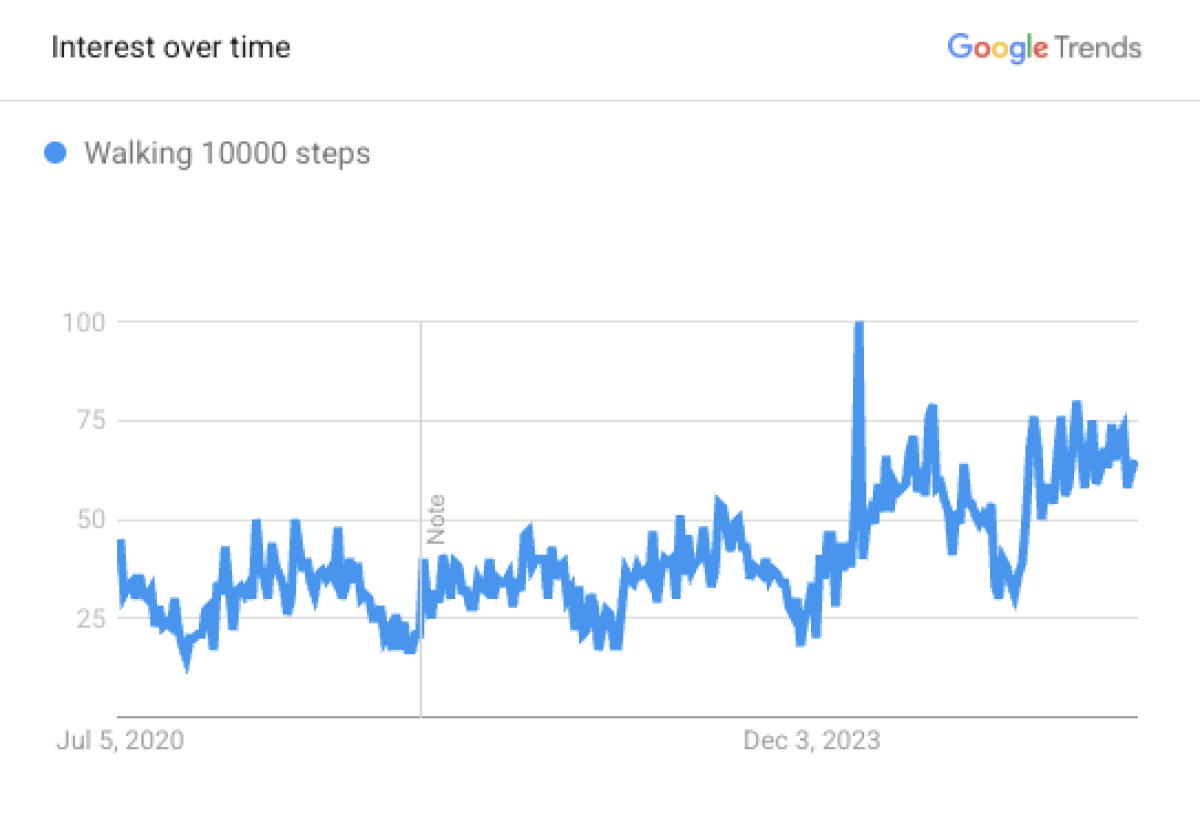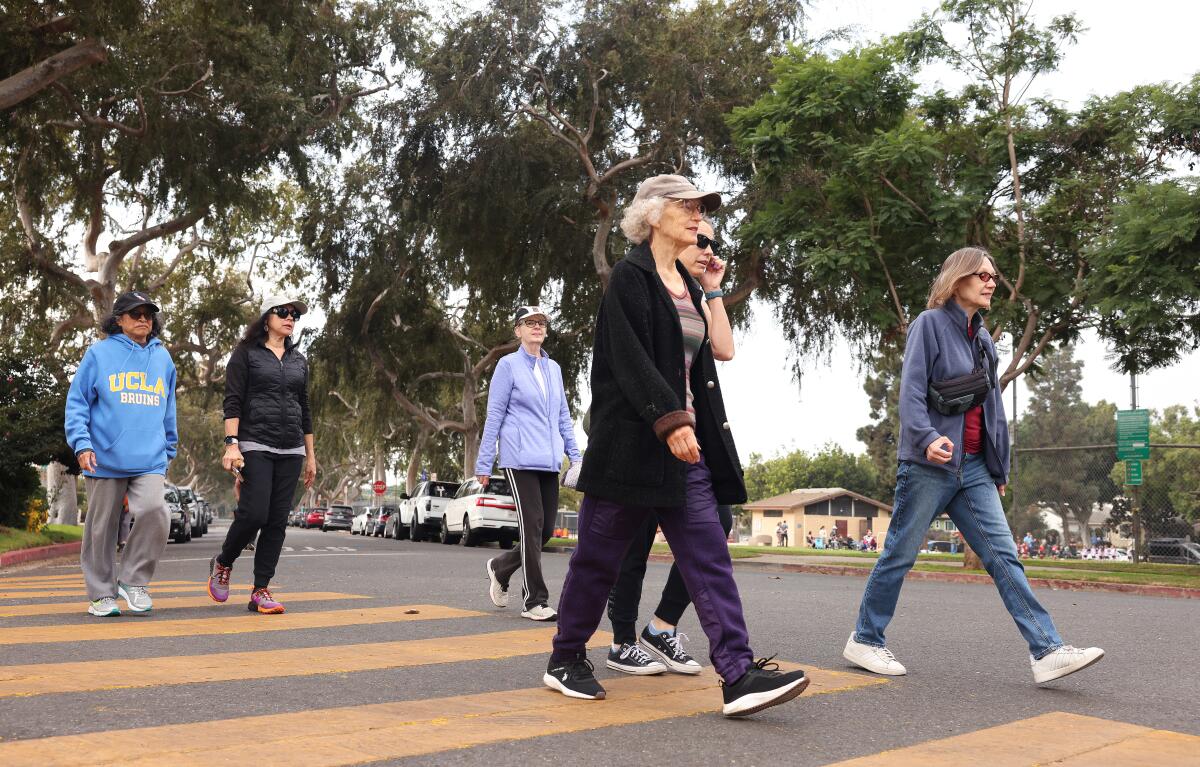Magic number appears in smart watches, fitness applications and office step difficulties. For many, taking 10,000 steps in a day has become a good sign of health-a target that is a reason to park a little further away from the block after lunch.
While target is widely adopted by doctors and patients, its origins are less scientific than some expected.
“All the idea behind 10,000 steps was actually a marketing campaign for a company that developed a pedometer in Japan, Dav said David Raichlen, Professor of Biological Sciences and Anthropology.
The idea of walking 10,000 steps a day has gained popularity in Japan, where a company introduced a pedometer called Manpo-Kei in the 1960s-a name that means “10,000 steps meter”. The product, which was released during the 1964 Tokyo Olympics, gave people a numerical target and helped to sell a pedometer.
“It was a little bright, Ra Raichlen said. “Is it pleasure? Yes.”

A couple benefit from pleasant weather to walk their dogs in the Venice Historical Region in Venice Beach.
(Allen J. Schaben / Los Angeles Times)
Researchers say he was caught for a reason and may have approached a significant extent, even if the number was not evidence based at that time.
Raichlen, in a strange way, was probably not so far away, even if they didn’t have any epidemiological data to support it at that time, ”Raichlen said.
In recent years since the 10,000 step target has gained attraction, researchers have tried to determine how many steps are actually linked to better health results. Some studies have shown that benefits such as reduction of the risk of cardiovascular disease have started in 2,500 to 3,000 steps per day. Others, health benefits of a plateau in 7.500 steps, he said.
Nevertheless, many public health messages continue to introduce Fitness viewers, including five -digit signs and fitbit and other smart devices.
Cardiology Chief in UCLA. GregG C. Fonarow said that it is a practical, easy -to -understand way to convey the physical activity instructions of step counts with patients. It usually recommends 10,000 steps and does not see the number randomly.
Fonarow said, “The number of steps is an easy and understandable way to convey a good level of physical activity for them.

The search for “Walking 10000 Steps” has increased in the last five years.
(Google Trends)
In accordance with the existing instructions for weekly exercise, about 10,000 steps were equal to about five miles of walking and approximately 150 -minute middle to intensive activities.
Nevertheless, Fonarow acknowledges that research findings have changed. Risk reduction referred to a study spreading in approximately 7,500 steps for old women, while other studies have been beneficial in 10,000 steps or more steps. “Walking is a great form of exercise, Fon Fonarow said. “It improves blood pressure, supports brain health, reduces insulin resistance and helps strengthen blood vessels.”
Raichlen said he typically avoided prescribing certain thresholds. Although 10,000 steps are a useful target for some, he said that this was not good health.
“A little better than nothing, and then a little more is better than that, Ra Raichlen said.
However, the type of walking is important. Researchers have found that cadence – how many steps a person has taken – how many steps can affect the effect of physical activity. A quick walk offers more cardiovascular benefits than a slower speed, even in the same total number of steps.

Wes Brumbaugh, Sol and Tucker O’Neill, are taking some steps in 41 miles in Los Angeles. In 2023, they went to Santa Monica from Pasadena.
(Irfan Khan / Los Angeles Times)
“You don’t have to run, Ra Raichlen said. “But more density is usually better.”
What is not clear, whether the benefits are a upper limit where it has started to decrease, or whether more steps has always provided more returns.
He said that more walking depends on the risk of various chronic conditions, including diabetes, dementia and cardiovascular disease, but after a certain point, the risk reduction plateau is dependent on the plateau.
“You are interested in the health result – heart disease, diabetes, dementia – there are different steps,” he added.
Raichlen also pointed out that the efficacy of a certain number of steps may vary according to age and that most of the existing studies are based on accelerations worn with wrist that can change in sensitivity.
“You can use multiple methods and you can get more than one different step count from the same person, Ra said Raichlen, who said that his brother -in -law and his son watched his steps on a recent journey to Disneyland using different devices with one by phone and the other Apple Watch.
He said that this variation strengthens the importance of using step counts as a guide rather than a strict rule.
“The best thing people can do is to be their own work, Ra Raichlen said. “Look what you’re doing today and try to do more tomorrow.”
Fonarow said that he often encourages patients to develop activity. For those who are largely still, it may not be practical to try to walk 10,000 steps on the first day. “We really need to personalize these suggestions,” he added that some people can choose to add resistance like a weighted backpack for additional benefits, but that it is not necessary for improved health.

Culver City Everwalk Walking Club, one of the few walking groups in LA, usually meets on the first Saturday of each month.
(Christina House / Los Angeles Times)
From USC to Keck Medicine. Parveen Garg also sees that patients aim to meet their step goals. Although it is ideal to spread activity during the week, it is good that some days are more active than others. For patients with limited time or energy, more walking during weekends or longer breaks can still provide significant benefits.
Garg, patients reminded that walking is beneficial even at lower levels, he said. More than one study shows that the risk of cardiovascular illness and premature death decreases in a measurable way starting in 2.500 steps per day.
Although it is ideal to spread activity during the week, it is good that some days are more active than others. For patients with limited time or energy, more walking during weekends or longer breaks can still provide significant benefits. Like other experts, Garg emphasizes that the benefits of the movement do not start in 10,000 steps – they can start much earlier.
“We love goals as people,” Garg said. “We like to feel that we have achieved something. We like to control boxes.… It gives people a target to succeed. In this respect, it is really great unless it deterrence.”
It encourages patients to give priority to aerobic activity – movement that increases the heart rate – even if it is mixed with short explosions or daily routines.
When a person walks 2,000 steps or 10,000 steps, local experts acknowledge that the key is consistency, and increasing activities may be useful over time.
“Just keep moving, Ra Raichlen said.



